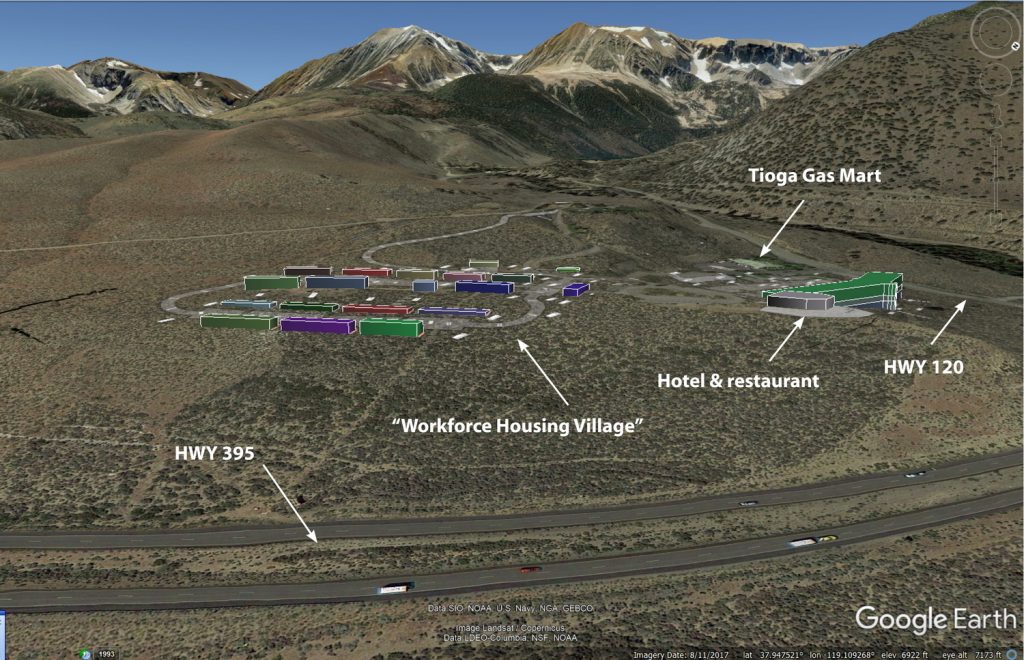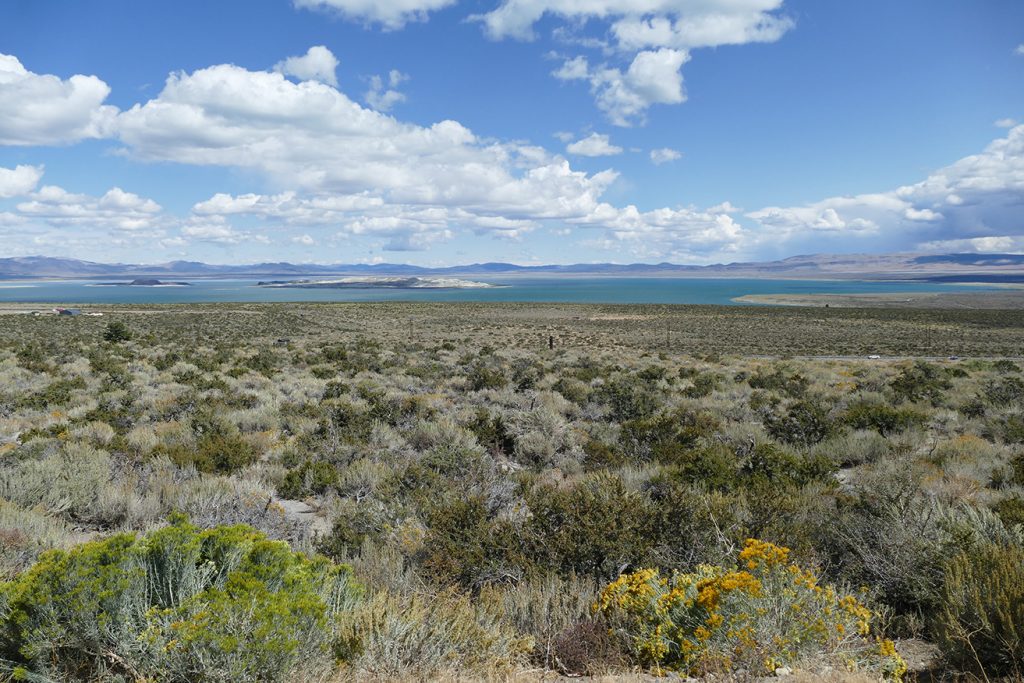
Mono County is considering a newly-proposed development of unprecedented scale in the Mono Basin. The controversial Tioga Inn project proposes an expansion at the Tioga Gas Mart (often called the Mobil Mart), and includes a 100-unit “Workforce Housing Village” of two-story buildings on top of a highly visible bluff at the junction of Highway 395 and Highway 120 West.

The Tioga Inn project has an alarming number of “significant and unavoidable adverse environmental impacts,” as stated in the Draft Supplemental Environmental Impact Report (DSEIR) released this summer. Among these impacts are drastic changes to the scenic quality of the Mono Basin National Forest Scenic Area and a new city-like skyline that will block clear views of the Sierra Crest as visitors travel along the Highway 395 Scenic Byway.
1,000+ comment letters
In August, the Mono Lake Committee and over 1,000 individuals, organizations, and agencies submitted comments on the DSEIR. Comment letters expressed concerns about impacts to Mono Basin scenic views, dark night skies, and to the small-town character of Lee Vining, among other issues.
Although the Tioga Inn proposal is a private development adjacent to Lee Vining, the impacts would go far beyond the physical property boundaries and threaten to compromise the scenic value of the Mono Basin, including views from South Tufa toward the Sierra escarpment. The scenic impacts, combined with the broad concern this proposal has raised within the local community, led the Committee to submit an extensive comment letter.
The Committee’s letter highlighted scenic impacts, hydrological concerns, effects on mule deer, and inconsistencies with the Mono Basin Community Plan. You can read the full comment letter, as well as the accompanying letter from our legal team here.
Significant visual impacts
The DSEIR proposes additional changes to the footprint and parcels surrounding the existing Tioga Gas Mart/Whoa Nellie Deli and existing residential units. Those structures, along with the ridgetop restaurant and two-story hotel, were approved as part of a 1993 Final Environmental Impact Report and Specific Plan. While the hotel and restaurant have not been constructed since being approved 26 years ago, the same owner is requesting changes that would increase the approved amount of housing from ten units to 100 apartment-style units with up to 150 new bedrooms, supporting outbuildings, a 30,000 gallon propane tank, and expanded gas islands with additional pumps for the existing gas station.
Sixteen two-story buildings would be highly visible along Highway 395, from South Tufa, Panum Crater, and other key visitation sites across the Mono Basin. Additionally, the dark sky resources of the Mono Basin would be significantly altered despite night-sky compliant lighting, as the elevated siting of the development on the moraine would broadcast ambient light out across the Mono Basin.
The DSEIR outlines an unacceptable number of adverse impacts that could be avoided if a more thoughtfully conceived project with adequate mitigations had been proposed. The current proposal expands and intensifies visual impacts in the project footprint and the DSEIR states that despite landscaping, construction, and design mitigation to minimize offsite views, the impact to scenic resources, visual character, and dark night skies is a “significant and unavoidable adverse impact.”

Impacts to deer, people, and the town of Lee Vining
If the project moves forward as proposed, it would further constrain and disrupt the migratory mule deer path out of Lee Vining Canyon, which would likely cause an increase in vehicle accidents with deer. Pedestrian, bicycle, and motor vehicle traffic would increase along Highway 395 and the current “potential impacts associated with increased non-motorized transit (particularly pedestrian and bicycle) between the site and Lee Vining would be significant and adverse.”
According to the DSEIR, the “Workforce Housing Village” would increase the population of the town of Lee Vining by 300%. As a result, the DSEIR found significant “impacts on police, fire, schools, and other services.”
While the DSEIR claims that the project is not in conflict with the Mono Basin Community Plan, the Committee’s analysis reveals the opposite. The Community Plan is the result of a comprehensive, two-year visioning process that involved the Lee Vining and Mono Basin community, the Mono Basin Regional Planning Advisory Committee, and Mono County staff, and has since been integrated into the Mono County General Plan.
The DSEIR glosses over a wide range of Community Plan objectives and cherry-picks a few supporting points from a Community Plan that overwhelmingly does not support the scale and scope of adverse impacts the Tioga Inn project currently proposes. The Community Plan values include: “Small, compact communities with a clear edge between developed and natural areas … a healthy natural environment with clean air and water, scenic grandeur, dark night skies, pristine wilderness, and open space.” The DSEIR specifically identifies significant, unmitigated adverse impacts to scenic grandeur and dark night skies, to name two examples.
Actual workforce housing?
While the proposal describes a “Workforce Housing Village,” and workforce housing is much needed in Mono County, the project is slated to serve the needs of the unbuilt hotel and restaurant, not alleviate local or countywide needs. Further, nothing about the proposal requires or ensures that the housing will be affordable for those earning an average wage in Mono County, let alone for employees working at the future hotel and restaurant (if and when they are constructed). The DSEIR expresses a wide range of possibilities for the apartment complex: it may be rented out to local ski areas for employee housing, be housing for any employed resident of Mono County, or “provide sufficient housing to accommodate a majority of the projected 187 future onsite employees.” Much confusion stems from a DSEIR that is inconsistent within its description, objectives, phasing, and analysis.
Mono County deserves better
While the current DSEIR outlines a project fraught with issues, alternative solutions could transform a scenic tragedy into a more regionally-compatible project. A number of possible mitigation options were left out of the DSEIR, including: siting off the bluff, project grading to reduce visibility, earthen berms, setbacks and one-story buildings, a reduced number of units, underground parking, separation of housing units, LEED certification, community connectivity, and sufficient mitigation funds. The Committee recommended these alternatives and mitigations as part of our comment letter in the expectation that a more thoughtful and creative project with fewer and less severe impacts could become a reality.
Comments still being accepted
The Mono Lake Committee sent out an email alert in August asking people to express their support for the Mono Basin’s world-class scenic views and dark night skies. Members and friends responded by writing more than 800 detailed comment letters about the proposed Tioga Inn project. Thank you!
Letters are still being accepted. According to Mono County, “The public is invited to comment until a final decision is made regardless of the closure date of the DSEIR comment period. Comments can be submitted after the close of the DSEIR comment
period and County staff commits to providing a response, even though not required, through public hearings before the Planning Commission and Board of Supervisors.”
Find more information and submit a letter here.
Next steps
The Committee expects that Mono County and the proponent will re-evaluate the overall property plan with the above mitigations and alternatives and include consideration of the fact that the hotel and restaurant have not been built in the nearly three decades since their approval. A new evaluation would enable improved project siting possibilities and more complete mitigations with fewer impacts. Such planning should involve the community, and the Committee is ready to participate as one of many stakeholders.
Because of the substantial changes needed to the proposal, the Committee has called for recirculation of the DSEIR once it has been improved so the public can review and comment on it again.
Mono County is required to respond to every individual, organization, and agency that submitted comments before the deadline, which, given the volume and diversity of comments, will take some time. Ultimately, a hopefully much-improved final SEIR will be released and the proposal will proceed to the Planning Commission for consideration and then to the Mono County Board of Supervisors for final action.
The Mono Lake Committee will continue to stay involved in the process. With better alternatives and mitigations, the Tioga Inn could be a project that is compatible with the scenic and natural values of the Mono Basin that residents and visitors have enjoyed for generations.
This post was also published as an article in the Fall 2019 Mono Lake Newsletter (pages 4, 5, & 11).
